Types and Purpose of Organisations: Explained
VerifiedAdded on 2022/12/28
|15
|5235
|90
AI Summary
This report discusses the various types and purposes of organisations, including public, private, and voluntary sectors, and their legal structures. It also explores the relationship between different organisational functions and how they link to organisational objectives and structures. The report focuses on the case of Sainsbury, a multinational supermarket company, to provide practical examples.
Contribute Materials
Your contribution can guide someone’s learning journey. Share your
documents today.
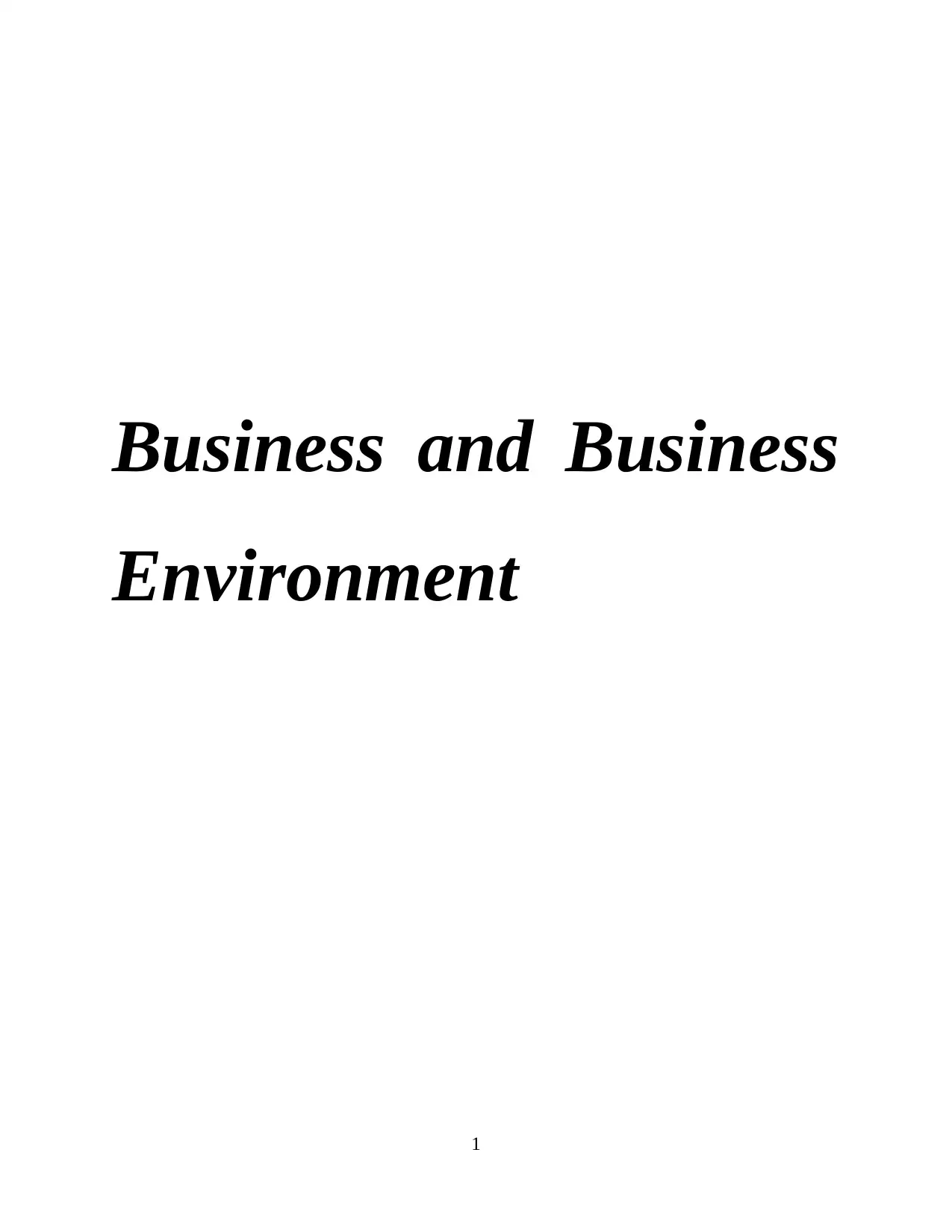
Business and Business
Environment
1
Environment
1
Secure Best Marks with AI Grader
Need help grading? Try our AI Grader for instant feedback on your assignments.
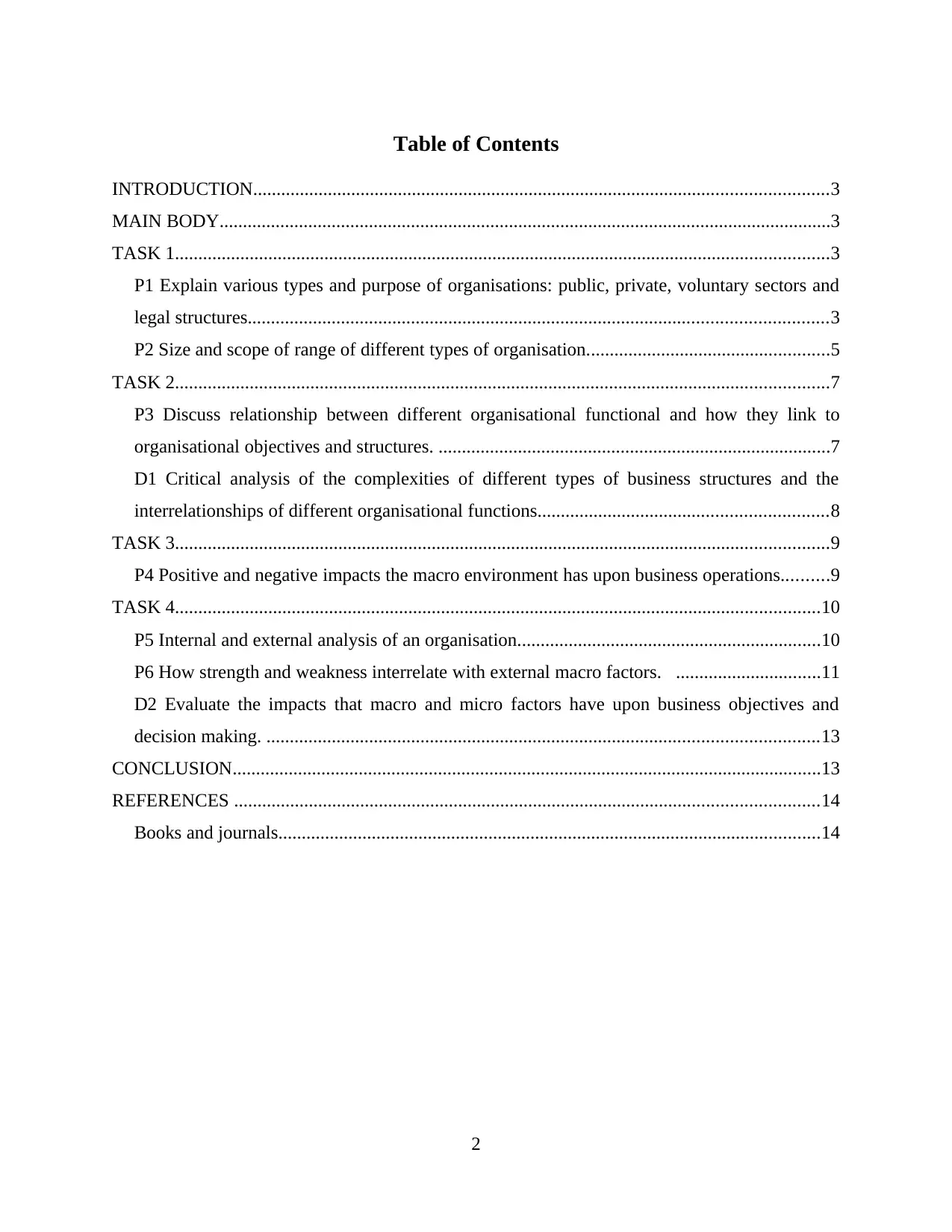
Table of Contents
INTRODUCTION...........................................................................................................................3
MAIN BODY...................................................................................................................................3
TASK 1............................................................................................................................................3
P1 Explain various types and purpose of organisations: public, private, voluntary sectors and
legal structures............................................................................................................................3
P2 Size and scope of range of different types of organisation....................................................5
TASK 2............................................................................................................................................7
P3 Discuss relationship between different organisational functional and how they link to
organisational objectives and structures. ....................................................................................7
D1 Critical analysis of the complexities of different types of business structures and the
interrelationships of different organisational functions..............................................................8
TASK 3............................................................................................................................................9
P4 Positive and negative impacts the macro environment has upon business operations..........9
TASK 4..........................................................................................................................................10
P5 Internal and external analysis of an organisation.................................................................10
P6 How strength and weakness interrelate with external macro factors. ...............................11
D2 Evaluate the impacts that macro and micro factors have upon business objectives and
decision making. ......................................................................................................................13
CONCLUSION..............................................................................................................................13
REFERENCES .............................................................................................................................14
Books and journals....................................................................................................................14
2
INTRODUCTION...........................................................................................................................3
MAIN BODY...................................................................................................................................3
TASK 1............................................................................................................................................3
P1 Explain various types and purpose of organisations: public, private, voluntary sectors and
legal structures............................................................................................................................3
P2 Size and scope of range of different types of organisation....................................................5
TASK 2............................................................................................................................................7
P3 Discuss relationship between different organisational functional and how they link to
organisational objectives and structures. ....................................................................................7
D1 Critical analysis of the complexities of different types of business structures and the
interrelationships of different organisational functions..............................................................8
TASK 3............................................................................................................................................9
P4 Positive and negative impacts the macro environment has upon business operations..........9
TASK 4..........................................................................................................................................10
P5 Internal and external analysis of an organisation.................................................................10
P6 How strength and weakness interrelate with external macro factors. ...............................11
D2 Evaluate the impacts that macro and micro factors have upon business objectives and
decision making. ......................................................................................................................13
CONCLUSION..............................................................................................................................13
REFERENCES .............................................................................................................................14
Books and journals....................................................................................................................14
2
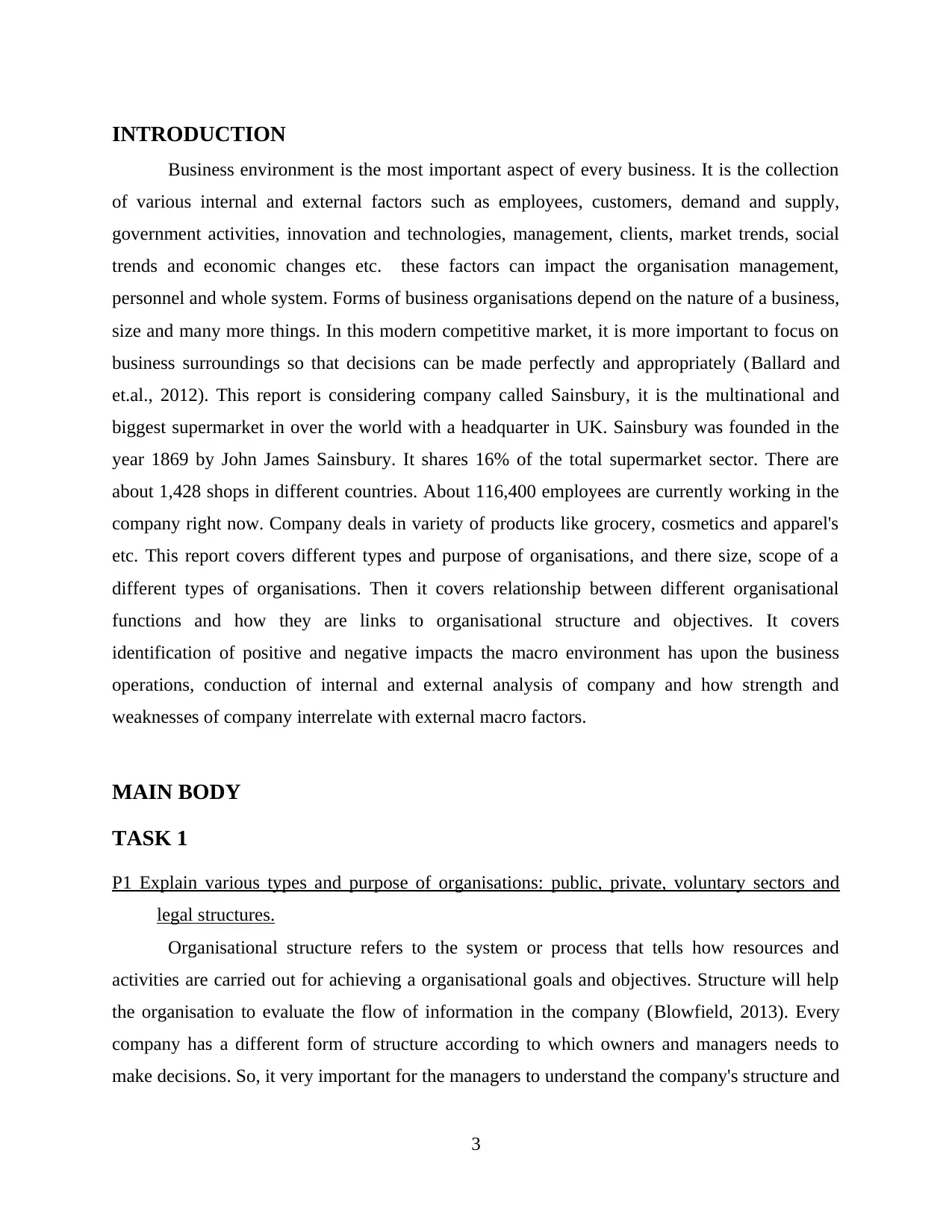
INTRODUCTION
Business environment is the most important aspect of every business. It is the collection
of various internal and external factors such as employees, customers, demand and supply,
government activities, innovation and technologies, management, clients, market trends, social
trends and economic changes etc. these factors can impact the organisation management,
personnel and whole system. Forms of business organisations depend on the nature of a business,
size and many more things. In this modern competitive market, it is more important to focus on
business surroundings so that decisions can be made perfectly and appropriately (Ballard and
et.al., 2012). This report is considering company called Sainsbury, it is the multinational and
biggest supermarket in over the world with a headquarter in UK. Sainsbury was founded in the
year 1869 by John James Sainsbury. It shares 16% of the total supermarket sector. There are
about 1,428 shops in different countries. About 116,400 employees are currently working in the
company right now. Company deals in variety of products like grocery, cosmetics and apparel's
etc. This report covers different types and purpose of organisations, and there size, scope of a
different types of organisations. Then it covers relationship between different organisational
functions and how they are links to organisational structure and objectives. It covers
identification of positive and negative impacts the macro environment has upon the business
operations, conduction of internal and external analysis of company and how strength and
weaknesses of company interrelate with external macro factors.
MAIN BODY
TASK 1
P1 Explain various types and purpose of organisations: public, private, voluntary sectors and
legal structures.
Organisational structure refers to the system or process that tells how resources and
activities are carried out for achieving a organisational goals and objectives. Structure will help
the organisation to evaluate the flow of information in the company (Blowfield, 2013). Every
company has a different form of structure according to which owners and managers needs to
make decisions. So, it very important for the managers to understand the company's structure and
3
Business environment is the most important aspect of every business. It is the collection
of various internal and external factors such as employees, customers, demand and supply,
government activities, innovation and technologies, management, clients, market trends, social
trends and economic changes etc. these factors can impact the organisation management,
personnel and whole system. Forms of business organisations depend on the nature of a business,
size and many more things. In this modern competitive market, it is more important to focus on
business surroundings so that decisions can be made perfectly and appropriately (Ballard and
et.al., 2012). This report is considering company called Sainsbury, it is the multinational and
biggest supermarket in over the world with a headquarter in UK. Sainsbury was founded in the
year 1869 by John James Sainsbury. It shares 16% of the total supermarket sector. There are
about 1,428 shops in different countries. About 116,400 employees are currently working in the
company right now. Company deals in variety of products like grocery, cosmetics and apparel's
etc. This report covers different types and purpose of organisations, and there size, scope of a
different types of organisations. Then it covers relationship between different organisational
functions and how they are links to organisational structure and objectives. It covers
identification of positive and negative impacts the macro environment has upon the business
operations, conduction of internal and external analysis of company and how strength and
weaknesses of company interrelate with external macro factors.
MAIN BODY
TASK 1
P1 Explain various types and purpose of organisations: public, private, voluntary sectors and
legal structures.
Organisational structure refers to the system or process that tells how resources and
activities are carried out for achieving a organisational goals and objectives. Structure will help
the organisation to evaluate the flow of information in the company (Blowfield, 2013). Every
company has a different form of structure according to which owners and managers needs to
make decisions. So, it very important for the managers to understand the company's structure and
3
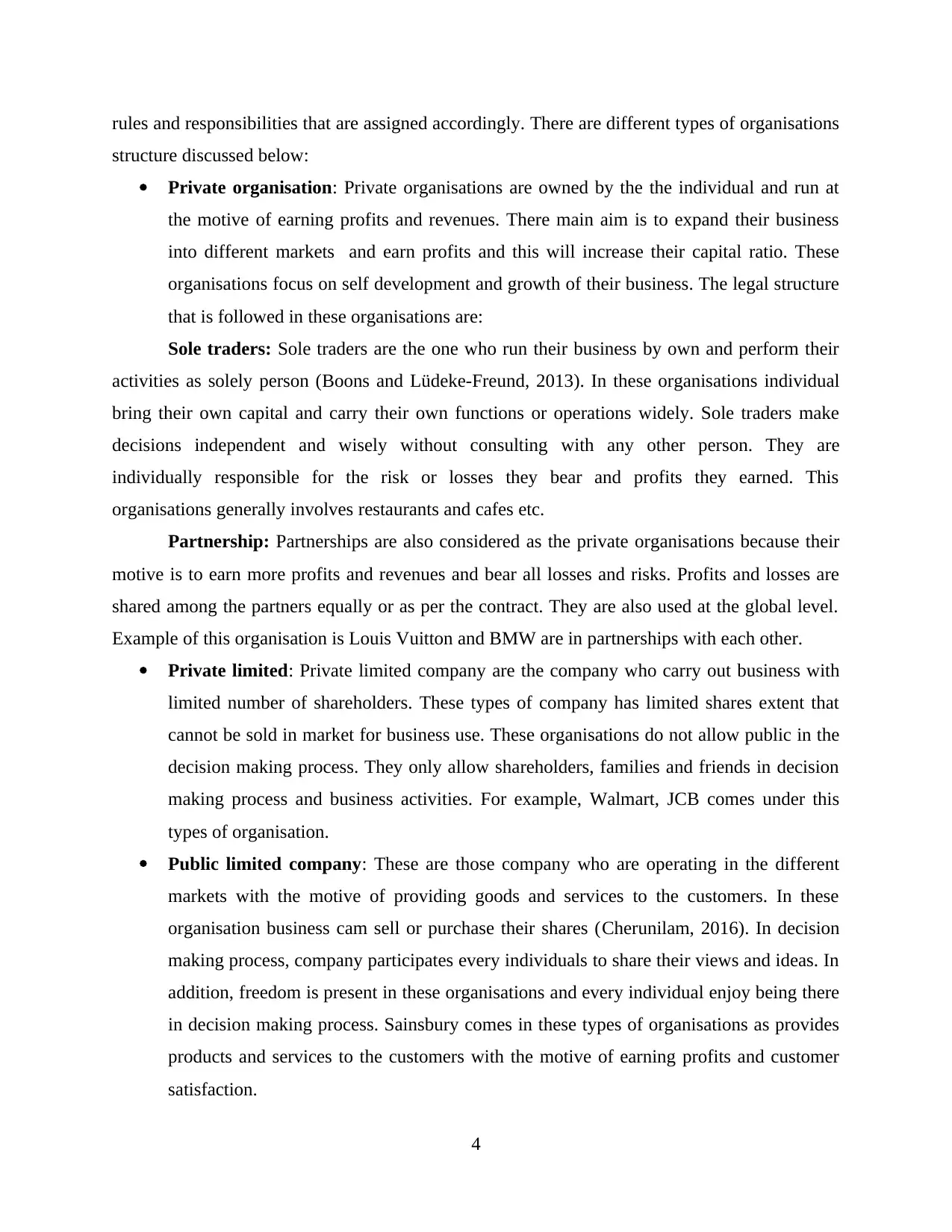
rules and responsibilities that are assigned accordingly. There are different types of organisations
structure discussed below:
Private organisation: Private organisations are owned by the the individual and run at
the motive of earning profits and revenues. There main aim is to expand their business
into different markets and earn profits and this will increase their capital ratio. These
organisations focus on self development and growth of their business. The legal structure
that is followed in these organisations are:
Sole traders: Sole traders are the one who run their business by own and perform their
activities as solely person (Boons and Lüdeke-Freund, 2013). In these organisations individual
bring their own capital and carry their own functions or operations widely. Sole traders make
decisions independent and wisely without consulting with any other person. They are
individually responsible for the risk or losses they bear and profits they earned. This
organisations generally involves restaurants and cafes etc.
Partnership: Partnerships are also considered as the private organisations because their
motive is to earn more profits and revenues and bear all losses and risks. Profits and losses are
shared among the partners equally or as per the contract. They are also used at the global level.
Example of this organisation is Louis Vuitton and BMW are in partnerships with each other.
Private limited: Private limited company are the company who carry out business with
limited number of shareholders. These types of company has limited shares extent that
cannot be sold in market for business use. These organisations do not allow public in the
decision making process. They only allow shareholders, families and friends in decision
making process and business activities. For example, Walmart, JCB comes under this
types of organisation.
Public limited company: These are those company who are operating in the different
markets with the motive of providing goods and services to the customers. In these
organisation business cam sell or purchase their shares (Cherunilam, 2016). In decision
making process, company participates every individuals to share their views and ideas. In
addition, freedom is present in these organisations and every individual enjoy being there
in decision making process. Sainsbury comes in these types of organisations as provides
products and services to the customers with the motive of earning profits and customer
satisfaction.
4
structure discussed below:
Private organisation: Private organisations are owned by the the individual and run at
the motive of earning profits and revenues. There main aim is to expand their business
into different markets and earn profits and this will increase their capital ratio. These
organisations focus on self development and growth of their business. The legal structure
that is followed in these organisations are:
Sole traders: Sole traders are the one who run their business by own and perform their
activities as solely person (Boons and Lüdeke-Freund, 2013). In these organisations individual
bring their own capital and carry their own functions or operations widely. Sole traders make
decisions independent and wisely without consulting with any other person. They are
individually responsible for the risk or losses they bear and profits they earned. This
organisations generally involves restaurants and cafes etc.
Partnership: Partnerships are also considered as the private organisations because their
motive is to earn more profits and revenues and bear all losses and risks. Profits and losses are
shared among the partners equally or as per the contract. They are also used at the global level.
Example of this organisation is Louis Vuitton and BMW are in partnerships with each other.
Private limited: Private limited company are the company who carry out business with
limited number of shareholders. These types of company has limited shares extent that
cannot be sold in market for business use. These organisations do not allow public in the
decision making process. They only allow shareholders, families and friends in decision
making process and business activities. For example, Walmart, JCB comes under this
types of organisation.
Public limited company: These are those company who are operating in the different
markets with the motive of providing goods and services to the customers. In these
organisation business cam sell or purchase their shares (Cherunilam, 2016). In decision
making process, company participates every individuals to share their views and ideas. In
addition, freedom is present in these organisations and every individual enjoy being there
in decision making process. Sainsbury comes in these types of organisations as provides
products and services to the customers with the motive of earning profits and customer
satisfaction.
4
Secure Best Marks with AI Grader
Need help grading? Try our AI Grader for instant feedback on your assignments.
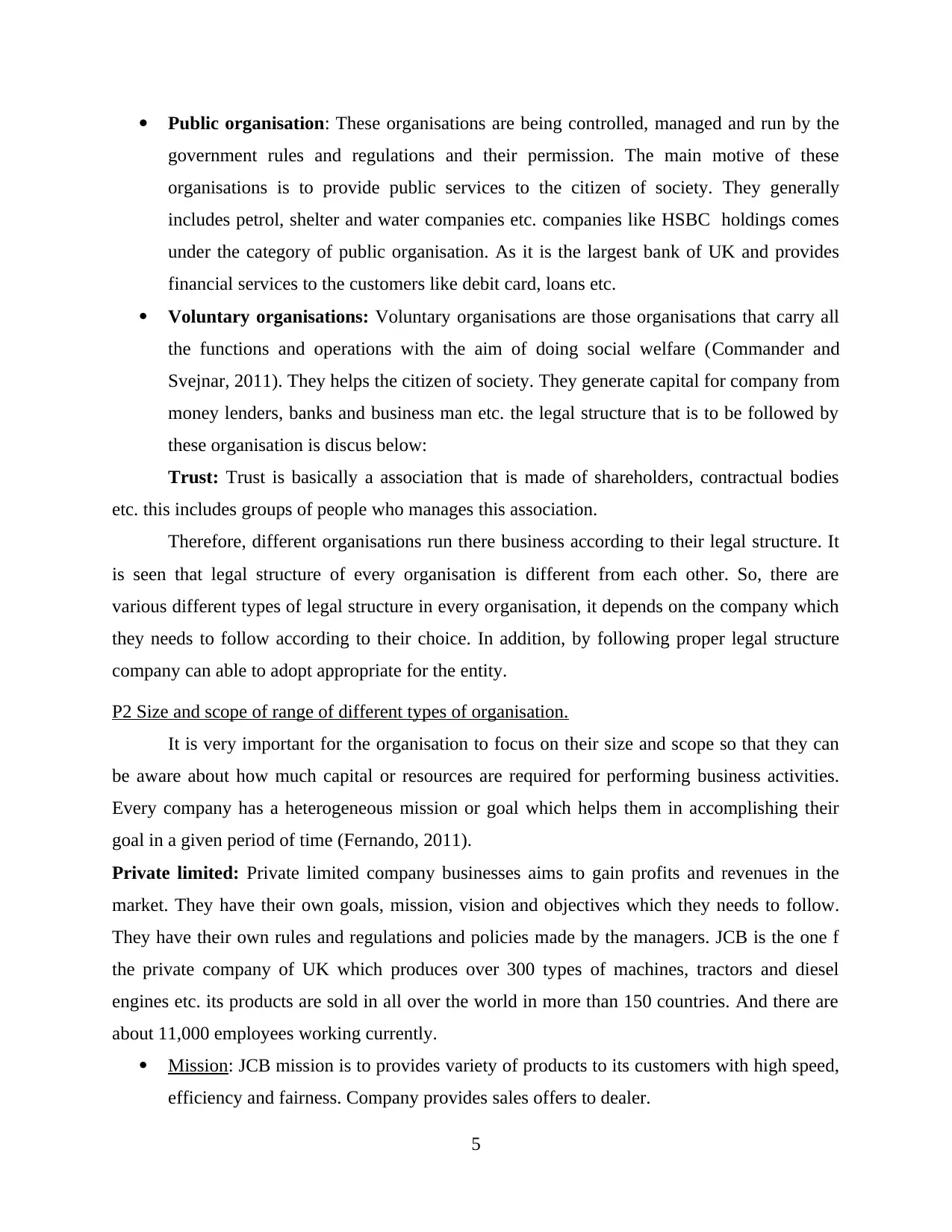
Public organisation: These organisations are being controlled, managed and run by the
government rules and regulations and their permission. The main motive of these
organisations is to provide public services to the citizen of society. They generally
includes petrol, shelter and water companies etc. companies like HSBC holdings comes
under the category of public organisation. As it is the largest bank of UK and provides
financial services to the customers like debit card, loans etc.
Voluntary organisations: Voluntary organisations are those organisations that carry all
the functions and operations with the aim of doing social welfare (Commander and
Svejnar, 2011). They helps the citizen of society. They generate capital for company from
money lenders, banks and business man etc. the legal structure that is to be followed by
these organisation is discus below:
Trust: Trust is basically a association that is made of shareholders, contractual bodies
etc. this includes groups of people who manages this association.
Therefore, different organisations run there business according to their legal structure. It
is seen that legal structure of every organisation is different from each other. So, there are
various different types of legal structure in every organisation, it depends on the company which
they needs to follow according to their choice. In addition, by following proper legal structure
company can able to adopt appropriate for the entity.
P2 Size and scope of range of different types of organisation.
It is very important for the organisation to focus on their size and scope so that they can
be aware about how much capital or resources are required for performing business activities.
Every company has a heterogeneous mission or goal which helps them in accomplishing their
goal in a given period of time (Fernando, 2011).
Private limited: Private limited company businesses aims to gain profits and revenues in the
market. They have their own goals, mission, vision and objectives which they needs to follow.
They have their own rules and regulations and policies made by the managers. JCB is the one f
the private company of UK which produces over 300 types of machines, tractors and diesel
engines etc. its products are sold in all over the world in more than 150 countries. And there are
about 11,000 employees working currently.
Mission: JCB mission is to provides variety of products to its customers with high speed,
efficiency and fairness. Company provides sales offers to dealer.
5
government rules and regulations and their permission. The main motive of these
organisations is to provide public services to the citizen of society. They generally
includes petrol, shelter and water companies etc. companies like HSBC holdings comes
under the category of public organisation. As it is the largest bank of UK and provides
financial services to the customers like debit card, loans etc.
Voluntary organisations: Voluntary organisations are those organisations that carry all
the functions and operations with the aim of doing social welfare (Commander and
Svejnar, 2011). They helps the citizen of society. They generate capital for company from
money lenders, banks and business man etc. the legal structure that is to be followed by
these organisation is discus below:
Trust: Trust is basically a association that is made of shareholders, contractual bodies
etc. this includes groups of people who manages this association.
Therefore, different organisations run there business according to their legal structure. It
is seen that legal structure of every organisation is different from each other. So, there are
various different types of legal structure in every organisation, it depends on the company which
they needs to follow according to their choice. In addition, by following proper legal structure
company can able to adopt appropriate for the entity.
P2 Size and scope of range of different types of organisation.
It is very important for the organisation to focus on their size and scope so that they can
be aware about how much capital or resources are required for performing business activities.
Every company has a heterogeneous mission or goal which helps them in accomplishing their
goal in a given period of time (Fernando, 2011).
Private limited: Private limited company businesses aims to gain profits and revenues in the
market. They have their own goals, mission, vision and objectives which they needs to follow.
They have their own rules and regulations and policies made by the managers. JCB is the one f
the private company of UK which produces over 300 types of machines, tractors and diesel
engines etc. its products are sold in all over the world in more than 150 countries. And there are
about 11,000 employees working currently.
Mission: JCB mission is to provides variety of products to its customers with high speed,
efficiency and fairness. Company provides sales offers to dealer.
5
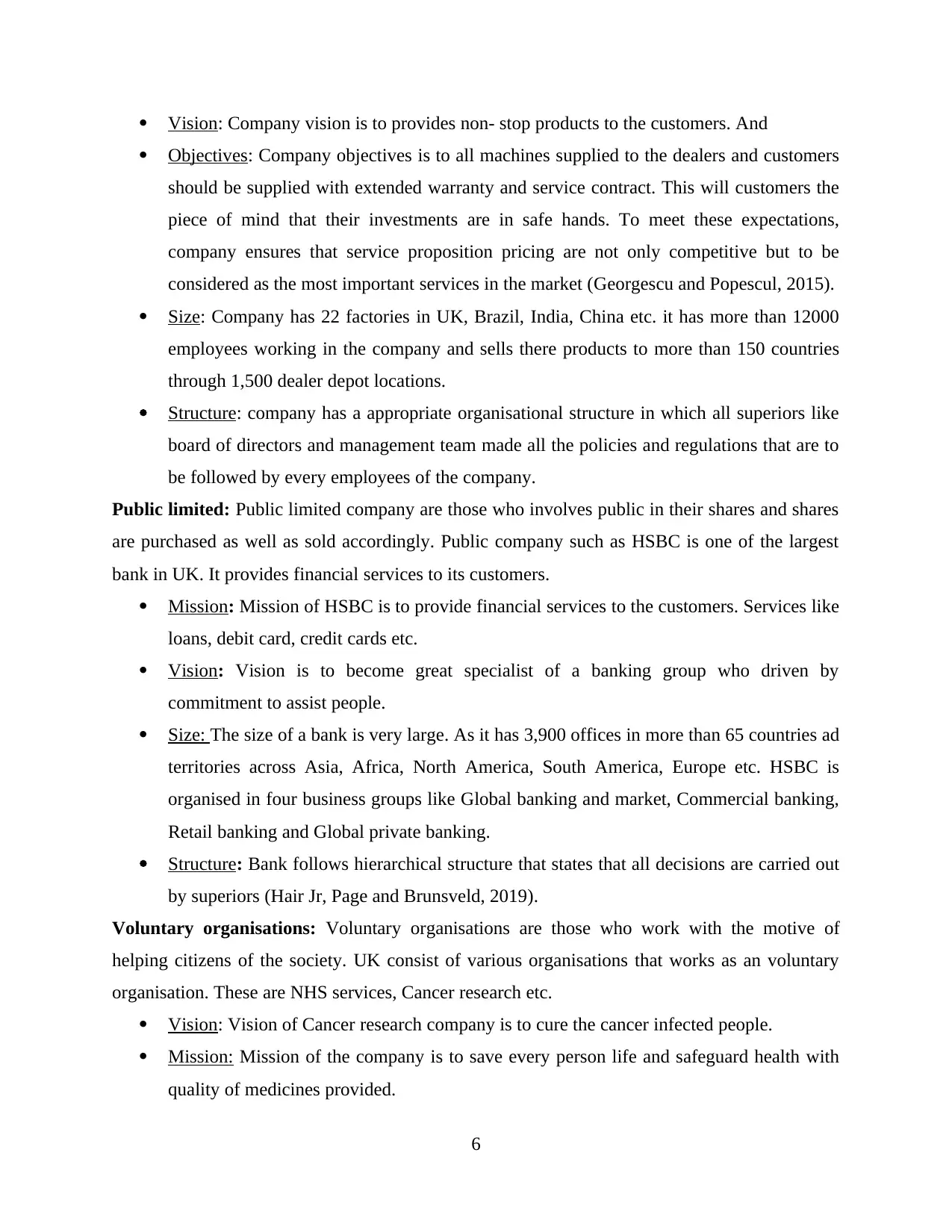
Vision: Company vision is to provides non- stop products to the customers. And
Objectives: Company objectives is to all machines supplied to the dealers and customers
should be supplied with extended warranty and service contract. This will customers the
piece of mind that their investments are in safe hands. To meet these expectations,
company ensures that service proposition pricing are not only competitive but to be
considered as the most important services in the market (Georgescu and Popescul, 2015).
Size: Company has 22 factories in UK, Brazil, India, China etc. it has more than 12000
employees working in the company and sells there products to more than 150 countries
through 1,500 dealer depot locations.
Structure: company has a appropriate organisational structure in which all superiors like
board of directors and management team made all the policies and regulations that are to
be followed by every employees of the company.
Public limited: Public limited company are those who involves public in their shares and shares
are purchased as well as sold accordingly. Public company such as HSBC is one of the largest
bank in UK. It provides financial services to its customers.
Mission: Mission of HSBC is to provide financial services to the customers. Services like
loans, debit card, credit cards etc.
Vision: Vision is to become great specialist of a banking group who driven by
commitment to assist people.
Size: The size of a bank is very large. As it has 3,900 offices in more than 65 countries ad
territories across Asia, Africa, North America, South America, Europe etc. HSBC is
organised in four business groups like Global banking and market, Commercial banking,
Retail banking and Global private banking.
Structure: Bank follows hierarchical structure that states that all decisions are carried out
by superiors (Hair Jr, Page and Brunsveld, 2019).
Voluntary organisations: Voluntary organisations are those who work with the motive of
helping citizens of the society. UK consist of various organisations that works as an voluntary
organisation. These are NHS services, Cancer research etc.
Vision: Vision of Cancer research company is to cure the cancer infected people.
Mission: Mission of the company is to save every person life and safeguard health with
quality of medicines provided.
6
Objectives: Company objectives is to all machines supplied to the dealers and customers
should be supplied with extended warranty and service contract. This will customers the
piece of mind that their investments are in safe hands. To meet these expectations,
company ensures that service proposition pricing are not only competitive but to be
considered as the most important services in the market (Georgescu and Popescul, 2015).
Size: Company has 22 factories in UK, Brazil, India, China etc. it has more than 12000
employees working in the company and sells there products to more than 150 countries
through 1,500 dealer depot locations.
Structure: company has a appropriate organisational structure in which all superiors like
board of directors and management team made all the policies and regulations that are to
be followed by every employees of the company.
Public limited: Public limited company are those who involves public in their shares and shares
are purchased as well as sold accordingly. Public company such as HSBC is one of the largest
bank in UK. It provides financial services to its customers.
Mission: Mission of HSBC is to provide financial services to the customers. Services like
loans, debit card, credit cards etc.
Vision: Vision is to become great specialist of a banking group who driven by
commitment to assist people.
Size: The size of a bank is very large. As it has 3,900 offices in more than 65 countries ad
territories across Asia, Africa, North America, South America, Europe etc. HSBC is
organised in four business groups like Global banking and market, Commercial banking,
Retail banking and Global private banking.
Structure: Bank follows hierarchical structure that states that all decisions are carried out
by superiors (Hair Jr, Page and Brunsveld, 2019).
Voluntary organisations: Voluntary organisations are those who work with the motive of
helping citizens of the society. UK consist of various organisations that works as an voluntary
organisation. These are NHS services, Cancer research etc.
Vision: Vision of Cancer research company is to cure the cancer infected people.
Mission: Mission of the company is to save every person life and safeguard health with
quality of medicines provided.
6
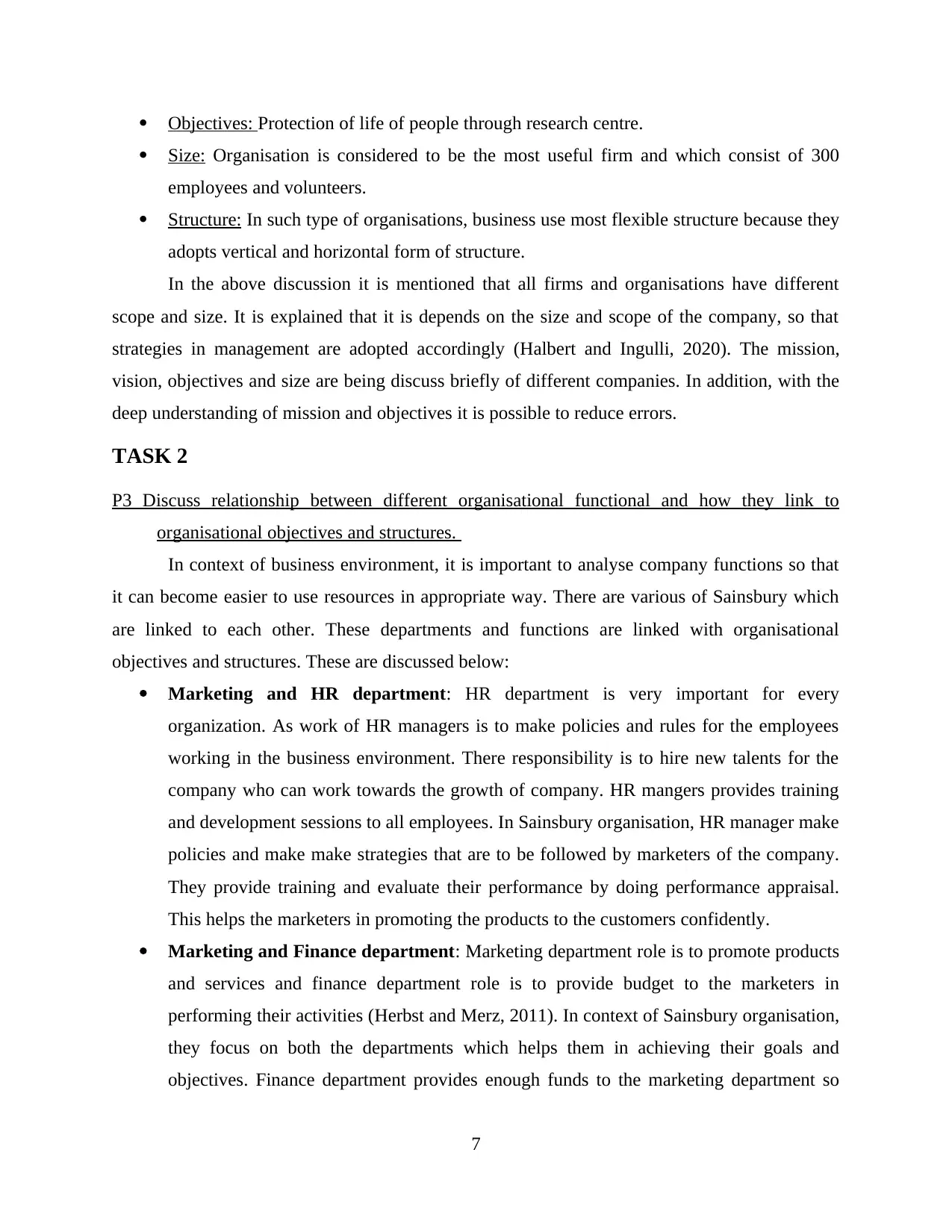
Objectives: Protection of life of people through research centre.
Size: Organisation is considered to be the most useful firm and which consist of 300
employees and volunteers.
Structure: In such type of organisations, business use most flexible structure because they
adopts vertical and horizontal form of structure.
In the above discussion it is mentioned that all firms and organisations have different
scope and size. It is explained that it is depends on the size and scope of the company, so that
strategies in management are adopted accordingly (Halbert and Ingulli, 2020). The mission,
vision, objectives and size are being discuss briefly of different companies. In addition, with the
deep understanding of mission and objectives it is possible to reduce errors.
TASK 2
P3 Discuss relationship between different organisational functional and how they link to
organisational objectives and structures.
In context of business environment, it is important to analyse company functions so that
it can become easier to use resources in appropriate way. There are various of Sainsbury which
are linked to each other. These departments and functions are linked with organisational
objectives and structures. These are discussed below:
Marketing and HR department: HR department is very important for every
organization. As work of HR managers is to make policies and rules for the employees
working in the business environment. There responsibility is to hire new talents for the
company who can work towards the growth of company. HR mangers provides training
and development sessions to all employees. In Sainsbury organisation, HR manager make
policies and make make strategies that are to be followed by marketers of the company.
They provide training and evaluate their performance by doing performance appraisal.
This helps the marketers in promoting the products to the customers confidently.
Marketing and Finance department: Marketing department role is to promote products
and services and finance department role is to provide budget to the marketers in
performing their activities (Herbst and Merz, 2011). In context of Sainsbury organisation,
they focus on both the departments which helps them in achieving their goals and
objectives. Finance department provides enough funds to the marketing department so
7
Size: Organisation is considered to be the most useful firm and which consist of 300
employees and volunteers.
Structure: In such type of organisations, business use most flexible structure because they
adopts vertical and horizontal form of structure.
In the above discussion it is mentioned that all firms and organisations have different
scope and size. It is explained that it is depends on the size and scope of the company, so that
strategies in management are adopted accordingly (Halbert and Ingulli, 2020). The mission,
vision, objectives and size are being discuss briefly of different companies. In addition, with the
deep understanding of mission and objectives it is possible to reduce errors.
TASK 2
P3 Discuss relationship between different organisational functional and how they link to
organisational objectives and structures.
In context of business environment, it is important to analyse company functions so that
it can become easier to use resources in appropriate way. There are various of Sainsbury which
are linked to each other. These departments and functions are linked with organisational
objectives and structures. These are discussed below:
Marketing and HR department: HR department is very important for every
organization. As work of HR managers is to make policies and rules for the employees
working in the business environment. There responsibility is to hire new talents for the
company who can work towards the growth of company. HR mangers provides training
and development sessions to all employees. In Sainsbury organisation, HR manager make
policies and make make strategies that are to be followed by marketers of the company.
They provide training and evaluate their performance by doing performance appraisal.
This helps the marketers in promoting the products to the customers confidently.
Marketing and Finance department: Marketing department role is to promote products
and services and finance department role is to provide budget to the marketers in
performing their activities (Herbst and Merz, 2011). In context of Sainsbury organisation,
they focus on both the departments which helps them in achieving their goals and
objectives. Finance department provides enough funds to the marketing department so
7
Paraphrase This Document
Need a fresh take? Get an instant paraphrase of this document with our AI Paraphraser
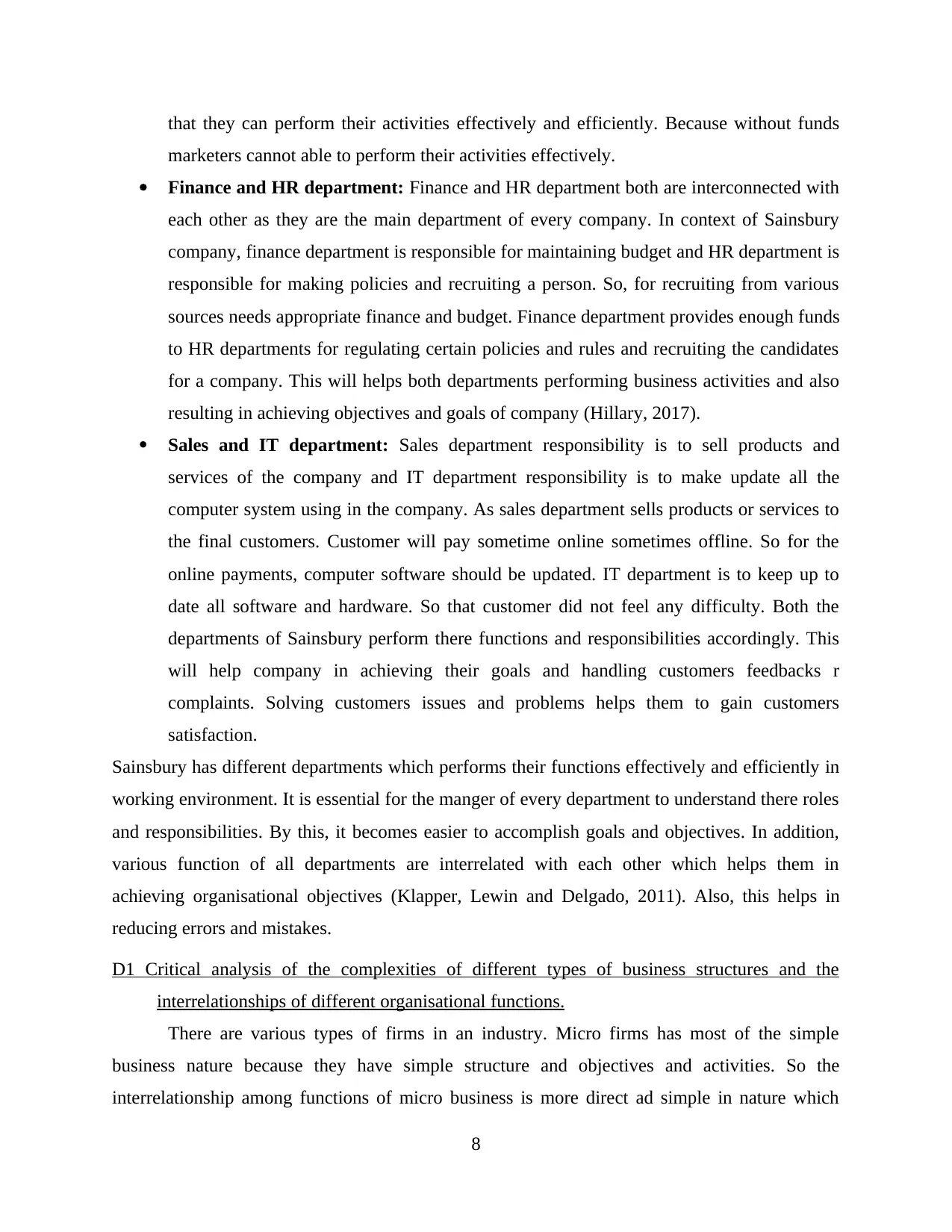
that they can perform their activities effectively and efficiently. Because without funds
marketers cannot able to perform their activities effectively.
Finance and HR department: Finance and HR department both are interconnected with
each other as they are the main department of every company. In context of Sainsbury
company, finance department is responsible for maintaining budget and HR department is
responsible for making policies and recruiting a person. So, for recruiting from various
sources needs appropriate finance and budget. Finance department provides enough funds
to HR departments for regulating certain policies and rules and recruiting the candidates
for a company. This will helps both departments performing business activities and also
resulting in achieving objectives and goals of company (Hillary, 2017).
Sales and IT department: Sales department responsibility is to sell products and
services of the company and IT department responsibility is to make update all the
computer system using in the company. As sales department sells products or services to
the final customers. Customer will pay sometime online sometimes offline. So for the
online payments, computer software should be updated. IT department is to keep up to
date all software and hardware. So that customer did not feel any difficulty. Both the
departments of Sainsbury perform there functions and responsibilities accordingly. This
will help company in achieving their goals and handling customers feedbacks r
complaints. Solving customers issues and problems helps them to gain customers
satisfaction.
Sainsbury has different departments which performs their functions effectively and efficiently in
working environment. It is essential for the manger of every department to understand there roles
and responsibilities. By this, it becomes easier to accomplish goals and objectives. In addition,
various function of all departments are interrelated with each other which helps them in
achieving organisational objectives (Klapper, Lewin and Delgado, 2011). Also, this helps in
reducing errors and mistakes.
D1 Critical analysis of the complexities of different types of business structures and the
interrelationships of different organisational functions.
There are various types of firms in an industry. Micro firms has most of the simple
business nature because they have simple structure and objectives and activities. So the
interrelationship among functions of micro business is more direct ad simple in nature which
8
marketers cannot able to perform their activities effectively.
Finance and HR department: Finance and HR department both are interconnected with
each other as they are the main department of every company. In context of Sainsbury
company, finance department is responsible for maintaining budget and HR department is
responsible for making policies and recruiting a person. So, for recruiting from various
sources needs appropriate finance and budget. Finance department provides enough funds
to HR departments for regulating certain policies and rules and recruiting the candidates
for a company. This will helps both departments performing business activities and also
resulting in achieving objectives and goals of company (Hillary, 2017).
Sales and IT department: Sales department responsibility is to sell products and
services of the company and IT department responsibility is to make update all the
computer system using in the company. As sales department sells products or services to
the final customers. Customer will pay sometime online sometimes offline. So for the
online payments, computer software should be updated. IT department is to keep up to
date all software and hardware. So that customer did not feel any difficulty. Both the
departments of Sainsbury perform there functions and responsibilities accordingly. This
will help company in achieving their goals and handling customers feedbacks r
complaints. Solving customers issues and problems helps them to gain customers
satisfaction.
Sainsbury has different departments which performs their functions effectively and efficiently in
working environment. It is essential for the manger of every department to understand there roles
and responsibilities. By this, it becomes easier to accomplish goals and objectives. In addition,
various function of all departments are interrelated with each other which helps them in
achieving organisational objectives (Klapper, Lewin and Delgado, 2011). Also, this helps in
reducing errors and mistakes.
D1 Critical analysis of the complexities of different types of business structures and the
interrelationships of different organisational functions.
There are various types of firms in an industry. Micro firms has most of the simple
business nature because they have simple structure and objectives and activities. So the
interrelationship among functions of micro business is more direct ad simple in nature which
8
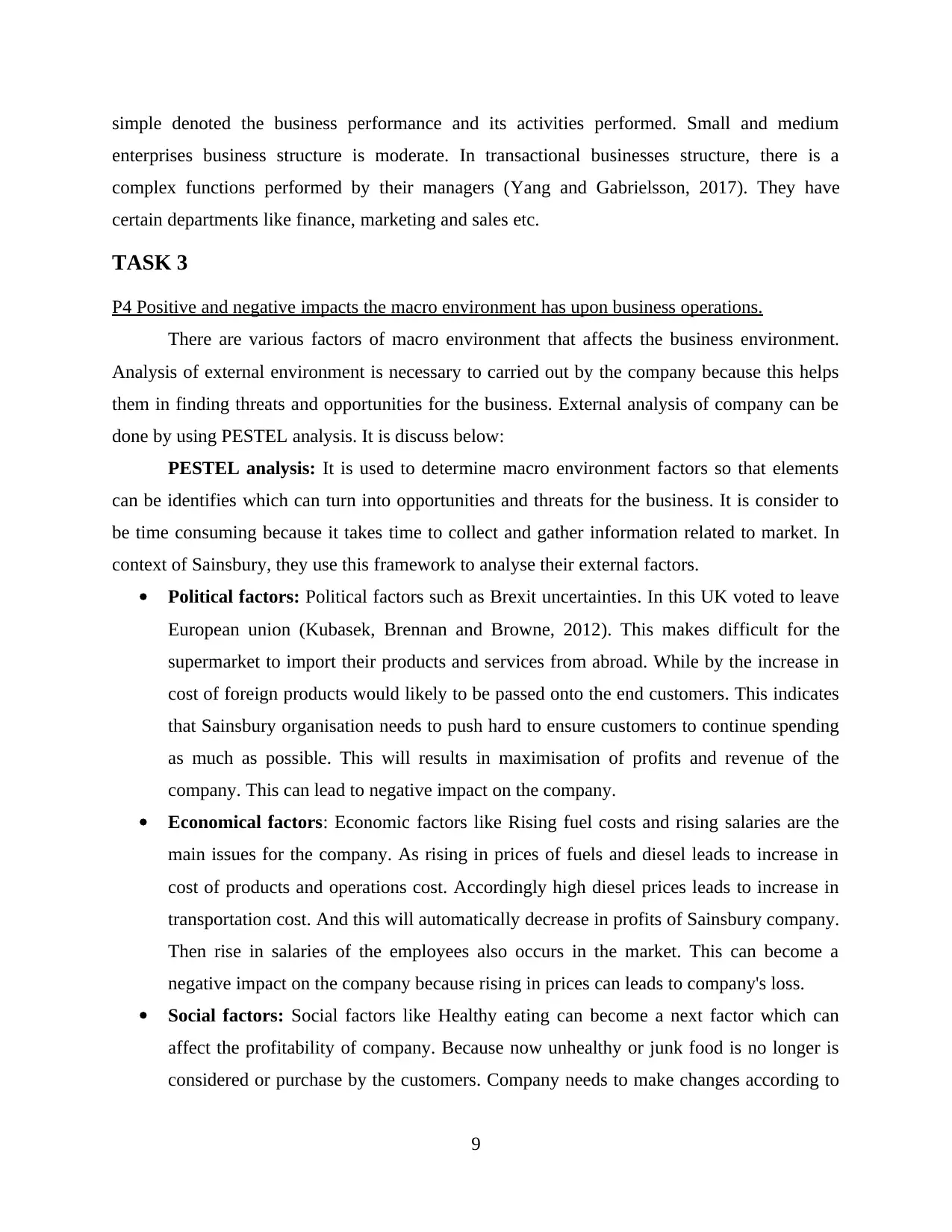
simple denoted the business performance and its activities performed. Small and medium
enterprises business structure is moderate. In transactional businesses structure, there is a
complex functions performed by their managers (Yang and Gabrielsson, 2017). They have
certain departments like finance, marketing and sales etc.
TASK 3
P4 Positive and negative impacts the macro environment has upon business operations.
There are various factors of macro environment that affects the business environment.
Analysis of external environment is necessary to carried out by the company because this helps
them in finding threats and opportunities for the business. External analysis of company can be
done by using PESTEL analysis. It is discuss below:
PESTEL analysis: It is used to determine macro environment factors so that elements
can be identifies which can turn into opportunities and threats for the business. It is consider to
be time consuming because it takes time to collect and gather information related to market. In
context of Sainsbury, they use this framework to analyse their external factors.
Political factors: Political factors such as Brexit uncertainties. In this UK voted to leave
European union (Kubasek, Brennan and Browne, 2012). This makes difficult for the
supermarket to import their products and services from abroad. While by the increase in
cost of foreign products would likely to be passed onto the end customers. This indicates
that Sainsbury organisation needs to push hard to ensure customers to continue spending
as much as possible. This will results in maximisation of profits and revenue of the
company. This can lead to negative impact on the company.
Economical factors: Economic factors like Rising fuel costs and rising salaries are the
main issues for the company. As rising in prices of fuels and diesel leads to increase in
cost of products and operations cost. Accordingly high diesel prices leads to increase in
transportation cost. And this will automatically decrease in profits of Sainsbury company.
Then rise in salaries of the employees also occurs in the market. This can become a
negative impact on the company because rising in prices can leads to company's loss.
Social factors: Social factors like Healthy eating can become a next factor which can
affect the profitability of company. Because now unhealthy or junk food is no longer is
considered or purchase by the customers. Company needs to make changes according to
9
enterprises business structure is moderate. In transactional businesses structure, there is a
complex functions performed by their managers (Yang and Gabrielsson, 2017). They have
certain departments like finance, marketing and sales etc.
TASK 3
P4 Positive and negative impacts the macro environment has upon business operations.
There are various factors of macro environment that affects the business environment.
Analysis of external environment is necessary to carried out by the company because this helps
them in finding threats and opportunities for the business. External analysis of company can be
done by using PESTEL analysis. It is discuss below:
PESTEL analysis: It is used to determine macro environment factors so that elements
can be identifies which can turn into opportunities and threats for the business. It is consider to
be time consuming because it takes time to collect and gather information related to market. In
context of Sainsbury, they use this framework to analyse their external factors.
Political factors: Political factors such as Brexit uncertainties. In this UK voted to leave
European union (Kubasek, Brennan and Browne, 2012). This makes difficult for the
supermarket to import their products and services from abroad. While by the increase in
cost of foreign products would likely to be passed onto the end customers. This indicates
that Sainsbury organisation needs to push hard to ensure customers to continue spending
as much as possible. This will results in maximisation of profits and revenue of the
company. This can lead to negative impact on the company.
Economical factors: Economic factors like Rising fuel costs and rising salaries are the
main issues for the company. As rising in prices of fuels and diesel leads to increase in
cost of products and operations cost. Accordingly high diesel prices leads to increase in
transportation cost. And this will automatically decrease in profits of Sainsbury company.
Then rise in salaries of the employees also occurs in the market. This can become a
negative impact on the company because rising in prices can leads to company's loss.
Social factors: Social factors like Healthy eating can become a next factor which can
affect the profitability of company. Because now unhealthy or junk food is no longer is
considered or purchase by the customers. Company needs to make changes according to
9
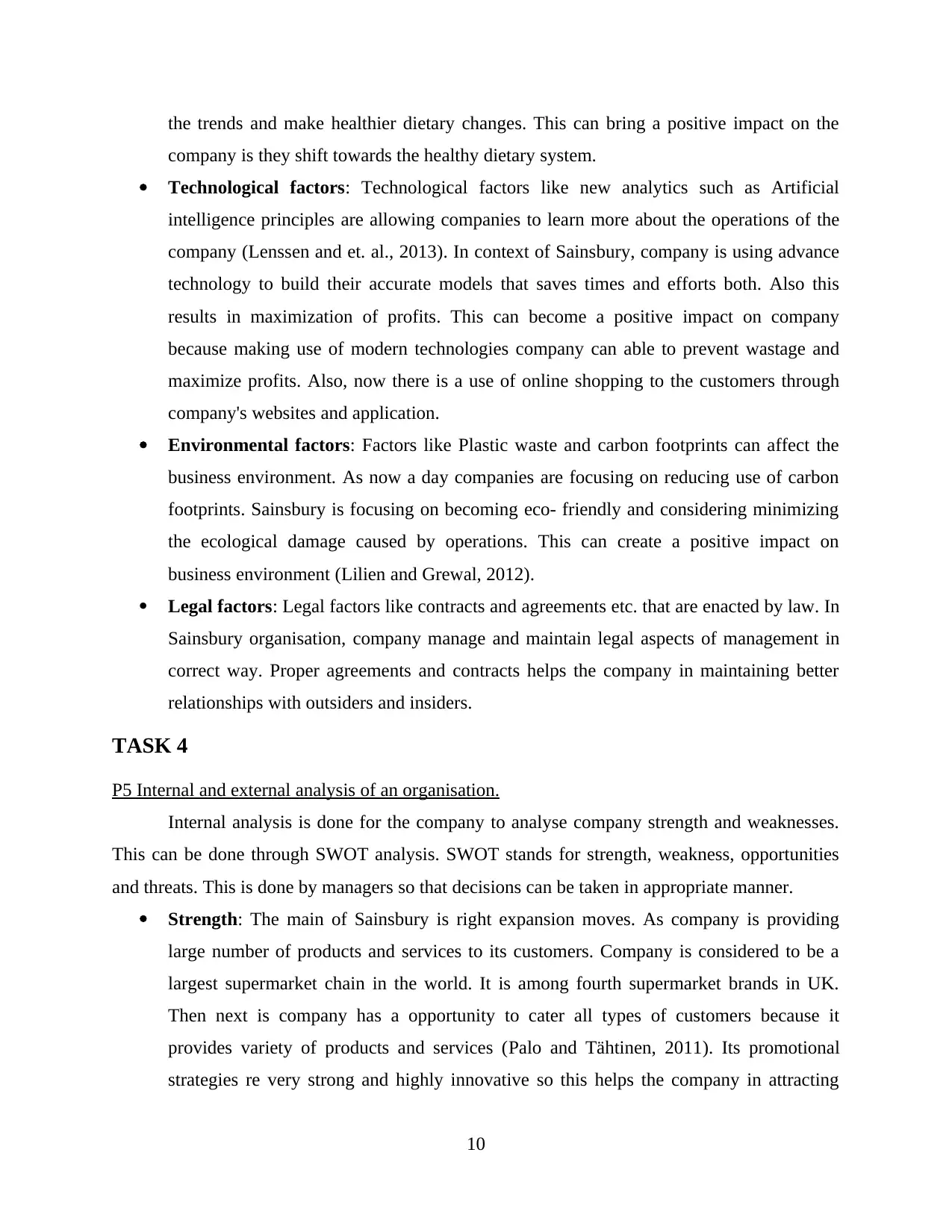
the trends and make healthier dietary changes. This can bring a positive impact on the
company is they shift towards the healthy dietary system.
Technological factors: Technological factors like new analytics such as Artificial
intelligence principles are allowing companies to learn more about the operations of the
company (Lenssen and et. al., 2013). In context of Sainsbury, company is using advance
technology to build their accurate models that saves times and efforts both. Also this
results in maximization of profits. This can become a positive impact on company
because making use of modern technologies company can able to prevent wastage and
maximize profits. Also, now there is a use of online shopping to the customers through
company's websites and application.
Environmental factors: Factors like Plastic waste and carbon footprints can affect the
business environment. As now a day companies are focusing on reducing use of carbon
footprints. Sainsbury is focusing on becoming eco- friendly and considering minimizing
the ecological damage caused by operations. This can create a positive impact on
business environment (Lilien and Grewal, 2012).
Legal factors: Legal factors like contracts and agreements etc. that are enacted by law. In
Sainsbury organisation, company manage and maintain legal aspects of management in
correct way. Proper agreements and contracts helps the company in maintaining better
relationships with outsiders and insiders.
TASK 4
P5 Internal and external analysis of an organisation.
Internal analysis is done for the company to analyse company strength and weaknesses.
This can be done through SWOT analysis. SWOT stands for strength, weakness, opportunities
and threats. This is done by managers so that decisions can be taken in appropriate manner.
Strength: The main of Sainsbury is right expansion moves. As company is providing
large number of products and services to its customers. Company is considered to be a
largest supermarket chain in the world. It is among fourth supermarket brands in UK.
Then next is company has a opportunity to cater all types of customers because it
provides variety of products and services (Palo and Tähtinen, 2011). Its promotional
strategies re very strong and highly innovative so this helps the company in attracting
10
company is they shift towards the healthy dietary system.
Technological factors: Technological factors like new analytics such as Artificial
intelligence principles are allowing companies to learn more about the operations of the
company (Lenssen and et. al., 2013). In context of Sainsbury, company is using advance
technology to build their accurate models that saves times and efforts both. Also this
results in maximization of profits. This can become a positive impact on company
because making use of modern technologies company can able to prevent wastage and
maximize profits. Also, now there is a use of online shopping to the customers through
company's websites and application.
Environmental factors: Factors like Plastic waste and carbon footprints can affect the
business environment. As now a day companies are focusing on reducing use of carbon
footprints. Sainsbury is focusing on becoming eco- friendly and considering minimizing
the ecological damage caused by operations. This can create a positive impact on
business environment (Lilien and Grewal, 2012).
Legal factors: Legal factors like contracts and agreements etc. that are enacted by law. In
Sainsbury organisation, company manage and maintain legal aspects of management in
correct way. Proper agreements and contracts helps the company in maintaining better
relationships with outsiders and insiders.
TASK 4
P5 Internal and external analysis of an organisation.
Internal analysis is done for the company to analyse company strength and weaknesses.
This can be done through SWOT analysis. SWOT stands for strength, weakness, opportunities
and threats. This is done by managers so that decisions can be taken in appropriate manner.
Strength: The main of Sainsbury is right expansion moves. As company is providing
large number of products and services to its customers. Company is considered to be a
largest supermarket chain in the world. It is among fourth supermarket brands in UK.
Then next is company has a opportunity to cater all types of customers because it
provides variety of products and services (Palo and Tähtinen, 2011). Its promotional
strategies re very strong and highly innovative so this helps the company in attracting
10
Secure Best Marks with AI Grader
Need help grading? Try our AI Grader for instant feedback on your assignments.
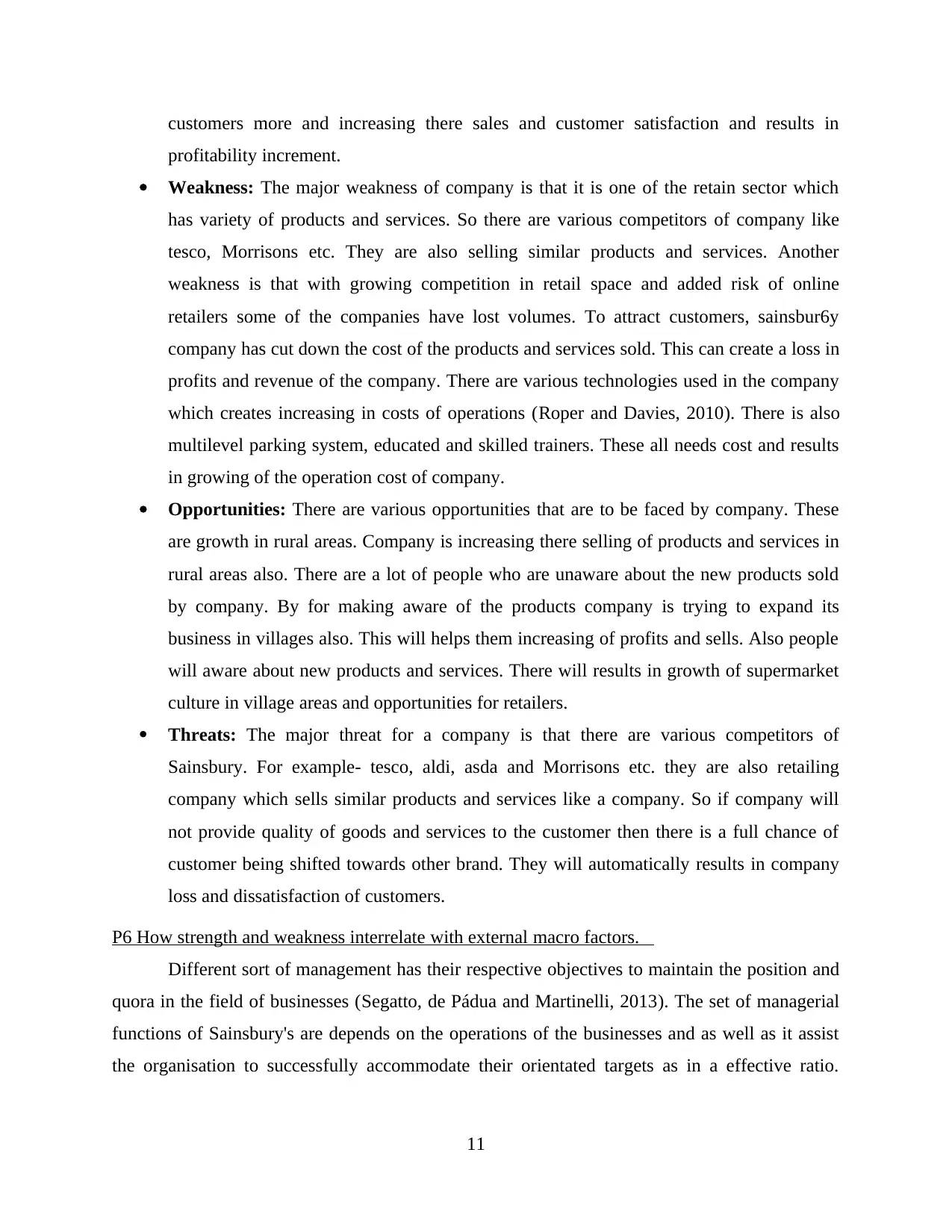
customers more and increasing there sales and customer satisfaction and results in
profitability increment.
Weakness: The major weakness of company is that it is one of the retain sector which
has variety of products and services. So there are various competitors of company like
tesco, Morrisons etc. They are also selling similar products and services. Another
weakness is that with growing competition in retail space and added risk of online
retailers some of the companies have lost volumes. To attract customers, sainsbur6y
company has cut down the cost of the products and services sold. This can create a loss in
profits and revenue of the company. There are various technologies used in the company
which creates increasing in costs of operations (Roper and Davies, 2010). There is also
multilevel parking system, educated and skilled trainers. These all needs cost and results
in growing of the operation cost of company.
Opportunities: There are various opportunities that are to be faced by company. These
are growth in rural areas. Company is increasing there selling of products and services in
rural areas also. There are a lot of people who are unaware about the new products sold
by company. By for making aware of the products company is trying to expand its
business in villages also. This will helps them increasing of profits and sells. Also people
will aware about new products and services. There will results in growth of supermarket
culture in village areas and opportunities for retailers.
Threats: The major threat for a company is that there are various competitors of
Sainsbury. For example- tesco, aldi, asda and Morrisons etc. they are also retailing
company which sells similar products and services like a company. So if company will
not provide quality of goods and services to the customer then there is a full chance of
customer being shifted towards other brand. They will automatically results in company
loss and dissatisfaction of customers.
P6 How strength and weakness interrelate with external macro factors.
Different sort of management has their respective objectives to maintain the position and
quora in the field of businesses (Segatto, de Pádua and Martinelli, 2013). The set of managerial
functions of Sainsbury's are depends on the operations of the businesses and as well as it assist
the organisation to successfully accommodate their orientated targets as in a effective ratio.
11
profitability increment.
Weakness: The major weakness of company is that it is one of the retain sector which
has variety of products and services. So there are various competitors of company like
tesco, Morrisons etc. They are also selling similar products and services. Another
weakness is that with growing competition in retail space and added risk of online
retailers some of the companies have lost volumes. To attract customers, sainsbur6y
company has cut down the cost of the products and services sold. This can create a loss in
profits and revenue of the company. There are various technologies used in the company
which creates increasing in costs of operations (Roper and Davies, 2010). There is also
multilevel parking system, educated and skilled trainers. These all needs cost and results
in growing of the operation cost of company.
Opportunities: There are various opportunities that are to be faced by company. These
are growth in rural areas. Company is increasing there selling of products and services in
rural areas also. There are a lot of people who are unaware about the new products sold
by company. By for making aware of the products company is trying to expand its
business in villages also. This will helps them increasing of profits and sells. Also people
will aware about new products and services. There will results in growth of supermarket
culture in village areas and opportunities for retailers.
Threats: The major threat for a company is that there are various competitors of
Sainsbury. For example- tesco, aldi, asda and Morrisons etc. they are also retailing
company which sells similar products and services like a company. So if company will
not provide quality of goods and services to the customer then there is a full chance of
customer being shifted towards other brand. They will automatically results in company
loss and dissatisfaction of customers.
P6 How strength and weakness interrelate with external macro factors.
Different sort of management has their respective objectives to maintain the position and
quora in the field of businesses (Segatto, de Pádua and Martinelli, 2013). The set of managerial
functions of Sainsbury's are depends on the operations of the businesses and as well as it assist
the organisation to successfully accommodate their orientated targets as in a effective ratio.
11
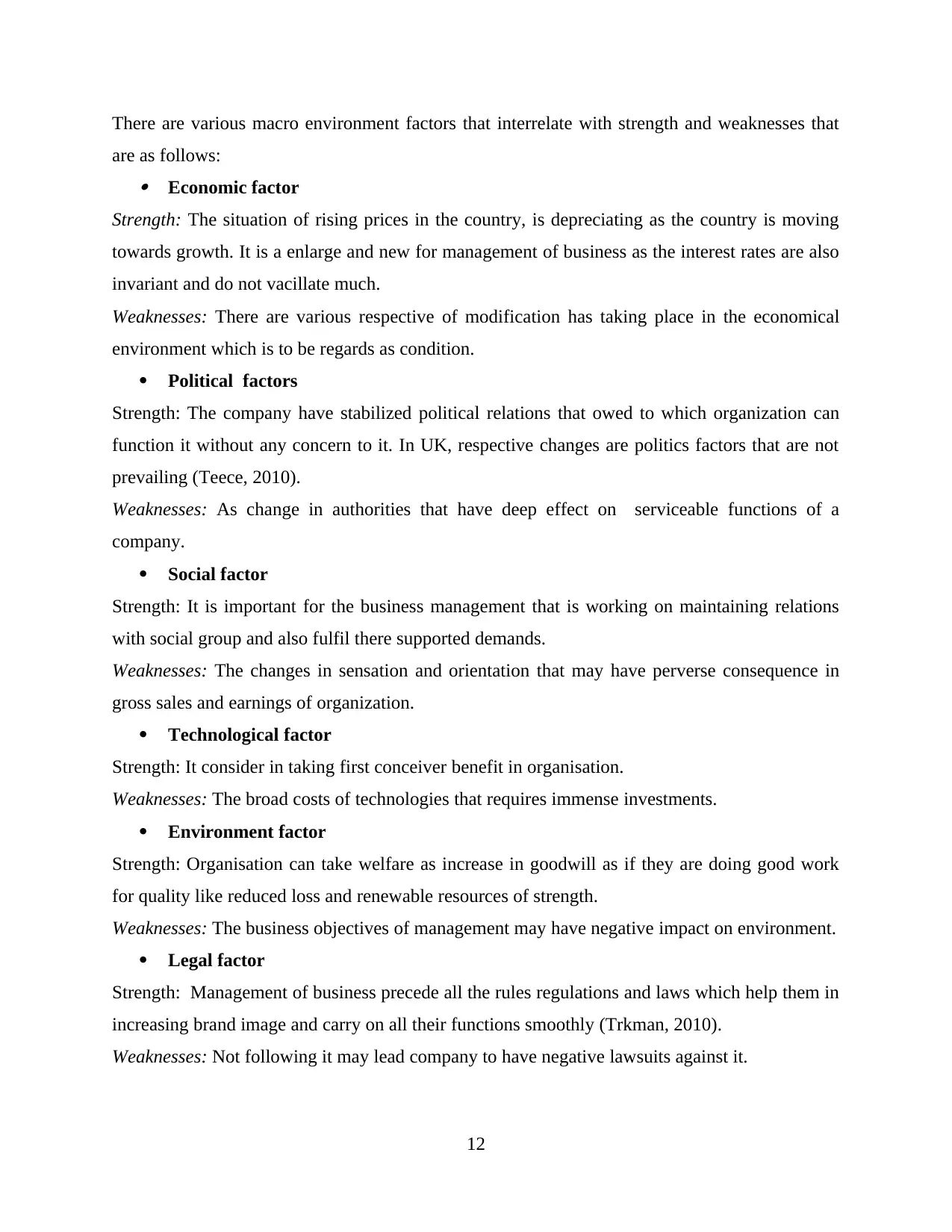
There are various macro environment factors that interrelate with strength and weaknesses that
are as follows: Economic factor
Strength: The situation of rising prices in the country, is depreciating as the country is moving
towards growth. It is a enlarge and new for management of business as the interest rates are also
invariant and do not vacillate much.
Weaknesses: There are various respective of modification has taking place in the economical
environment which is to be regards as condition.
Political factors
Strength: The company have stabilized political relations that owed to which organization can
function it without any concern to it. In UK, respective changes are politics factors that are not
prevailing (Teece, 2010).
Weaknesses: As change in authorities that have deep effect on serviceable functions of a
company.
Social factor
Strength: It is important for the business management that is working on maintaining relations
with social group and also fulfil there supported demands.
Weaknesses: The changes in sensation and orientation that may have perverse consequence in
gross sales and earnings of organization.
Technological factor
Strength: It consider in taking first conceiver benefit in organisation.
Weaknesses: The broad costs of technologies that requires immense investments.
Environment factor
Strength: Organisation can take welfare as increase in goodwill as if they are doing good work
for quality like reduced loss and renewable resources of strength.
Weaknesses: The business objectives of management may have negative impact on environment.
Legal factor
Strength: Management of business precede all the rules regulations and laws which help them in
increasing brand image and carry on all their functions smoothly (Trkman, 2010).
Weaknesses: Not following it may lead company to have negative lawsuits against it.
12
are as follows: Economic factor
Strength: The situation of rising prices in the country, is depreciating as the country is moving
towards growth. It is a enlarge and new for management of business as the interest rates are also
invariant and do not vacillate much.
Weaknesses: There are various respective of modification has taking place in the economical
environment which is to be regards as condition.
Political factors
Strength: The company have stabilized political relations that owed to which organization can
function it without any concern to it. In UK, respective changes are politics factors that are not
prevailing (Teece, 2010).
Weaknesses: As change in authorities that have deep effect on serviceable functions of a
company.
Social factor
Strength: It is important for the business management that is working on maintaining relations
with social group and also fulfil there supported demands.
Weaknesses: The changes in sensation and orientation that may have perverse consequence in
gross sales and earnings of organization.
Technological factor
Strength: It consider in taking first conceiver benefit in organisation.
Weaknesses: The broad costs of technologies that requires immense investments.
Environment factor
Strength: Organisation can take welfare as increase in goodwill as if they are doing good work
for quality like reduced loss and renewable resources of strength.
Weaknesses: The business objectives of management may have negative impact on environment.
Legal factor
Strength: Management of business precede all the rules regulations and laws which help them in
increasing brand image and carry on all their functions smoothly (Trkman, 2010).
Weaknesses: Not following it may lead company to have negative lawsuits against it.
12
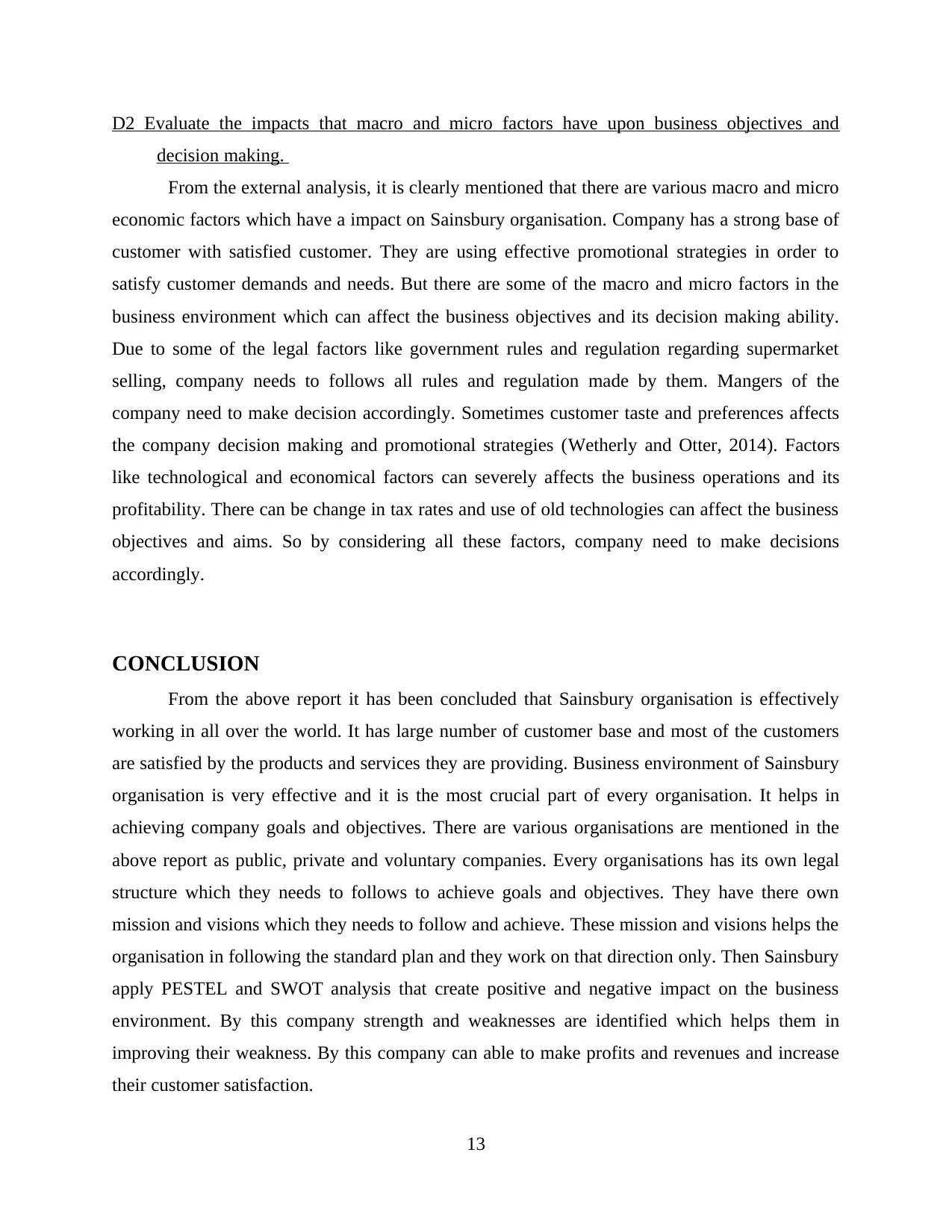
D2 Evaluate the impacts that macro and micro factors have upon business objectives and
decision making.
From the external analysis, it is clearly mentioned that there are various macro and micro
economic factors which have a impact on Sainsbury organisation. Company has a strong base of
customer with satisfied customer. They are using effective promotional strategies in order to
satisfy customer demands and needs. But there are some of the macro and micro factors in the
business environment which can affect the business objectives and its decision making ability.
Due to some of the legal factors like government rules and regulation regarding supermarket
selling, company needs to follows all rules and regulation made by them. Mangers of the
company need to make decision accordingly. Sometimes customer taste and preferences affects
the company decision making and promotional strategies (Wetherly and Otter, 2014). Factors
like technological and economical factors can severely affects the business operations and its
profitability. There can be change in tax rates and use of old technologies can affect the business
objectives and aims. So by considering all these factors, company need to make decisions
accordingly.
CONCLUSION
From the above report it has been concluded that Sainsbury organisation is effectively
working in all over the world. It has large number of customer base and most of the customers
are satisfied by the products and services they are providing. Business environment of Sainsbury
organisation is very effective and it is the most crucial part of every organisation. It helps in
achieving company goals and objectives. There are various organisations are mentioned in the
above report as public, private and voluntary companies. Every organisations has its own legal
structure which they needs to follows to achieve goals and objectives. They have there own
mission and visions which they needs to follow and achieve. These mission and visions helps the
organisation in following the standard plan and they work on that direction only. Then Sainsbury
apply PESTEL and SWOT analysis that create positive and negative impact on the business
environment. By this company strength and weaknesses are identified which helps them in
improving their weakness. By this company can able to make profits and revenues and increase
their customer satisfaction.
13
decision making.
From the external analysis, it is clearly mentioned that there are various macro and micro
economic factors which have a impact on Sainsbury organisation. Company has a strong base of
customer with satisfied customer. They are using effective promotional strategies in order to
satisfy customer demands and needs. But there are some of the macro and micro factors in the
business environment which can affect the business objectives and its decision making ability.
Due to some of the legal factors like government rules and regulation regarding supermarket
selling, company needs to follows all rules and regulation made by them. Mangers of the
company need to make decision accordingly. Sometimes customer taste and preferences affects
the company decision making and promotional strategies (Wetherly and Otter, 2014). Factors
like technological and economical factors can severely affects the business operations and its
profitability. There can be change in tax rates and use of old technologies can affect the business
objectives and aims. So by considering all these factors, company need to make decisions
accordingly.
CONCLUSION
From the above report it has been concluded that Sainsbury organisation is effectively
working in all over the world. It has large number of customer base and most of the customers
are satisfied by the products and services they are providing. Business environment of Sainsbury
organisation is very effective and it is the most crucial part of every organisation. It helps in
achieving company goals and objectives. There are various organisations are mentioned in the
above report as public, private and voluntary companies. Every organisations has its own legal
structure which they needs to follows to achieve goals and objectives. They have there own
mission and visions which they needs to follow and achieve. These mission and visions helps the
organisation in following the standard plan and they work on that direction only. Then Sainsbury
apply PESTEL and SWOT analysis that create positive and negative impact on the business
environment. By this company strength and weaknesses are identified which helps them in
improving their weakness. By this company can able to make profits and revenues and increase
their customer satisfaction.
13
Paraphrase This Document
Need a fresh take? Get an instant paraphrase of this document with our AI Paraphraser
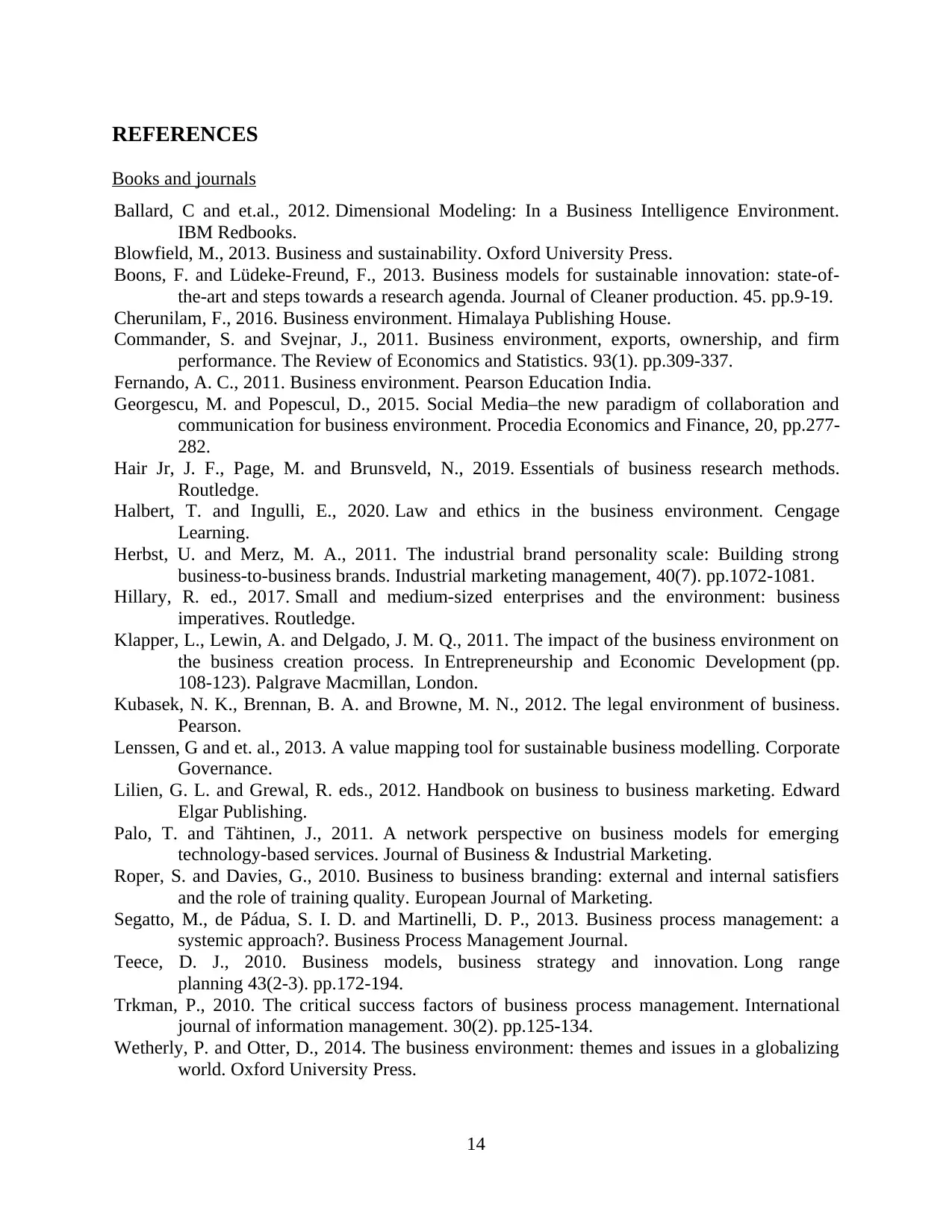
REFERENCES
Books and journals
Ballard, C and et.al., 2012. Dimensional Modeling: In a Business Intelligence Environment.
IBM Redbooks.
Blowfield, M., 2013. Business and sustainability. Oxford University Press.
Boons, F. and Lüdeke-Freund, F., 2013. Business models for sustainable innovation: state-of-
the-art and steps towards a research agenda. Journal of Cleaner production. 45. pp.9-19.
Cherunilam, F., 2016. Business environment. Himalaya Publishing House.
Commander, S. and Svejnar, J., 2011. Business environment, exports, ownership, and firm
performance. The Review of Economics and Statistics. 93(1). pp.309-337.
Fernando, A. C., 2011. Business environment. Pearson Education India.
Georgescu, M. and Popescul, D., 2015. Social Media–the new paradigm of collaboration and
communication for business environment. Procedia Economics and Finance, 20, pp.277-
282.
Hair Jr, J. F., Page, M. and Brunsveld, N., 2019. Essentials of business research methods.
Routledge.
Halbert, T. and Ingulli, E., 2020. Law and ethics in the business environment. Cengage
Learning.
Herbst, U. and Merz, M. A., 2011. The industrial brand personality scale: Building strong
business-to-business brands. Industrial marketing management, 40(7). pp.1072-1081.
Hillary, R. ed., 2017. Small and medium-sized enterprises and the environment: business
imperatives. Routledge.
Klapper, L., Lewin, A. and Delgado, J. M. Q., 2011. The impact of the business environment on
the business creation process. In Entrepreneurship and Economic Development (pp.
108-123). Palgrave Macmillan, London.
Kubasek, N. K., Brennan, B. A. and Browne, M. N., 2012. The legal environment of business.
Pearson.
Lenssen, G and et. al., 2013. A value mapping tool for sustainable business modelling. Corporate
Governance.
Lilien, G. L. and Grewal, R. eds., 2012. Handbook on business to business marketing. Edward
Elgar Publishing.
Palo, T. and Tähtinen, J., 2011. A network perspective on business models for emerging
technology‐based services. Journal of Business & Industrial Marketing.
Roper, S. and Davies, G., 2010. Business to business branding: external and internal satisfiers
and the role of training quality. European Journal of Marketing.
Segatto, M., de Pádua, S. I. D. and Martinelli, D. P., 2013. Business process management: a
systemic approach?. Business Process Management Journal.
Teece, D. J., 2010. Business models, business strategy and innovation. Long range
planning 43(2-3). pp.172-194.
Trkman, P., 2010. The critical success factors of business process management. International
journal of information management. 30(2). pp.125-134.
Wetherly, P. and Otter, D., 2014. The business environment: themes and issues in a globalizing
world. Oxford University Press.
14
Books and journals
Ballard, C and et.al., 2012. Dimensional Modeling: In a Business Intelligence Environment.
IBM Redbooks.
Blowfield, M., 2013. Business and sustainability. Oxford University Press.
Boons, F. and Lüdeke-Freund, F., 2013. Business models for sustainable innovation: state-of-
the-art and steps towards a research agenda. Journal of Cleaner production. 45. pp.9-19.
Cherunilam, F., 2016. Business environment. Himalaya Publishing House.
Commander, S. and Svejnar, J., 2011. Business environment, exports, ownership, and firm
performance. The Review of Economics and Statistics. 93(1). pp.309-337.
Fernando, A. C., 2011. Business environment. Pearson Education India.
Georgescu, M. and Popescul, D., 2015. Social Media–the new paradigm of collaboration and
communication for business environment. Procedia Economics and Finance, 20, pp.277-
282.
Hair Jr, J. F., Page, M. and Brunsveld, N., 2019. Essentials of business research methods.
Routledge.
Halbert, T. and Ingulli, E., 2020. Law and ethics in the business environment. Cengage
Learning.
Herbst, U. and Merz, M. A., 2011. The industrial brand personality scale: Building strong
business-to-business brands. Industrial marketing management, 40(7). pp.1072-1081.
Hillary, R. ed., 2017. Small and medium-sized enterprises and the environment: business
imperatives. Routledge.
Klapper, L., Lewin, A. and Delgado, J. M. Q., 2011. The impact of the business environment on
the business creation process. In Entrepreneurship and Economic Development (pp.
108-123). Palgrave Macmillan, London.
Kubasek, N. K., Brennan, B. A. and Browne, M. N., 2012. The legal environment of business.
Pearson.
Lenssen, G and et. al., 2013. A value mapping tool for sustainable business modelling. Corporate
Governance.
Lilien, G. L. and Grewal, R. eds., 2012. Handbook on business to business marketing. Edward
Elgar Publishing.
Palo, T. and Tähtinen, J., 2011. A network perspective on business models for emerging
technology‐based services. Journal of Business & Industrial Marketing.
Roper, S. and Davies, G., 2010. Business to business branding: external and internal satisfiers
and the role of training quality. European Journal of Marketing.
Segatto, M., de Pádua, S. I. D. and Martinelli, D. P., 2013. Business process management: a
systemic approach?. Business Process Management Journal.
Teece, D. J., 2010. Business models, business strategy and innovation. Long range
planning 43(2-3). pp.172-194.
Trkman, P., 2010. The critical success factors of business process management. International
journal of information management. 30(2). pp.125-134.
Wetherly, P. and Otter, D., 2014. The business environment: themes and issues in a globalizing
world. Oxford University Press.
14
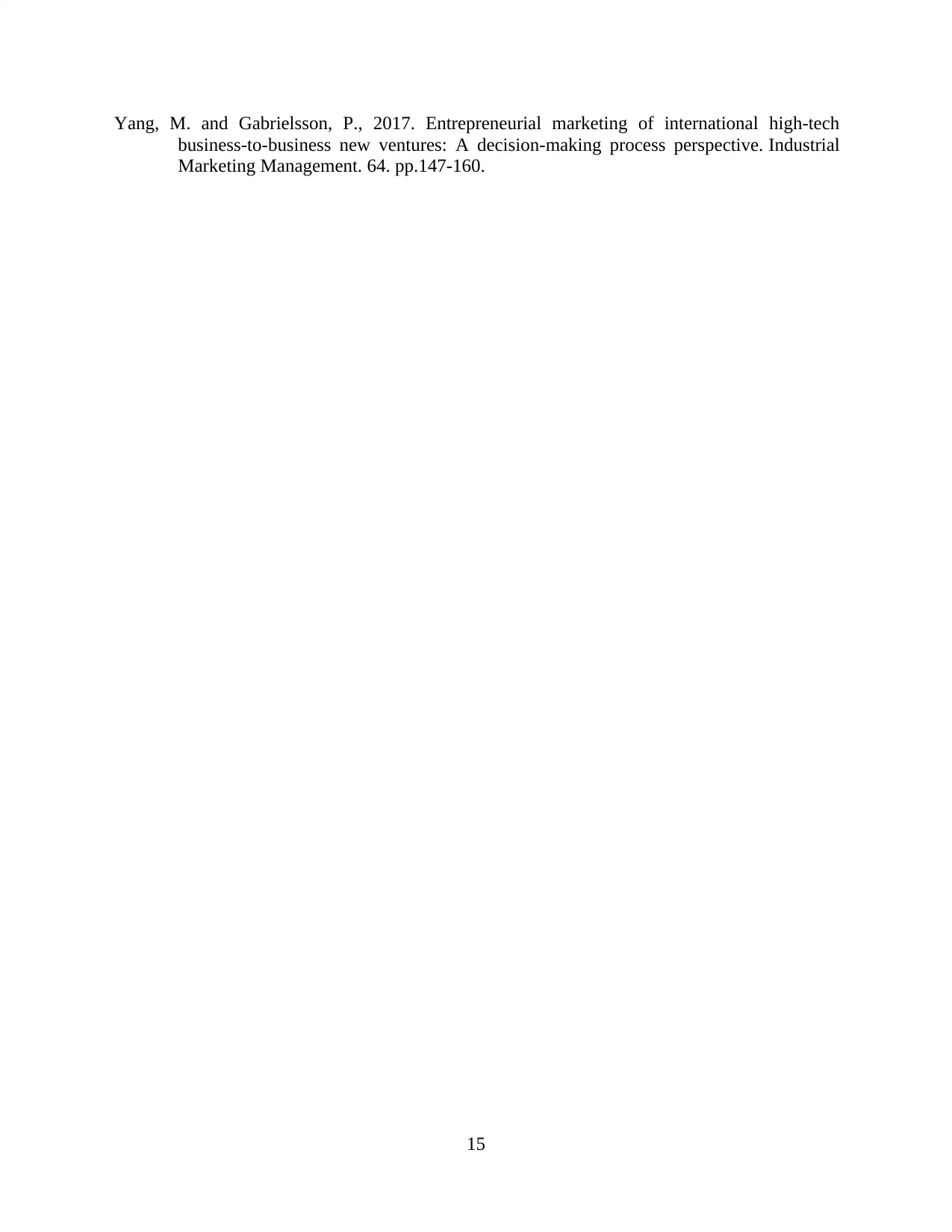
Yang, M. and Gabrielsson, P., 2017. Entrepreneurial marketing of international high-tech
business-to-business new ventures: A decision-making process perspective. Industrial
Marketing Management. 64. pp.147-160.
15
business-to-business new ventures: A decision-making process perspective. Industrial
Marketing Management. 64. pp.147-160.
15
1 out of 15
Related Documents
Your All-in-One AI-Powered Toolkit for Academic Success.
+13062052269
info@desklib.com
Available 24*7 on WhatsApp / Email
![[object Object]](/_next/static/media/star-bottom.7253800d.svg)
Unlock your academic potential
© 2024 | Zucol Services PVT LTD | All rights reserved.





